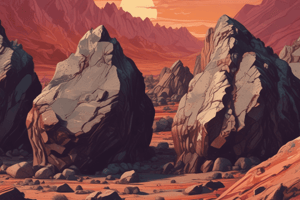Podcast
Questions and Answers
What are igneous rocks formed from?
What are igneous rocks formed from?
- Pressure and heat on existing rocks
- Cooling and solidifying of magma or lava (correct)
- Weathering and erosion of sedimentary rocks
- Deposition of organic matter
Where can igneous rocks be found?
Where can igneous rocks be found?
- Only on the surface of active volcanic mountains
- In riverbeds and lakes
- On the surface of the moon
- At the bottom of the ocean and deep underground (correct)
What is the theory that states the Earth's crust is broken up into plates called?
What is the theory that states the Earth's crust is broken up into plates called?
- Continental drift theory
- Plate tectonics (correct)
- Crustal fracturing theory
- Tectonic plate splitting theory
What are the massive sections of the Earth's crust called?
What are the massive sections of the Earth's crust called?
What is the name given to magma that reaches the surface of the Earth?
What is the name given to magma that reaches the surface of the Earth?
What leads to the formation of igneous rocks?
What leads to the formation of igneous rocks?
What is the process of igneous rock formation linked to?
What is the process of igneous rock formation linked to?
What type of tectonic plate movement is responsible for the formation of the Mid-Atlantic Ridge?
What type of tectonic plate movement is responsible for the formation of the Mid-Atlantic Ridge?
What happens when oceanic crust is pushed below continental crust at a subduction zone?
What happens when oceanic crust is pushed below continental crust at a subduction zone?
What is the result of the convergence of tectonic plates in the Ring of Fire area?
What is the result of the convergence of tectonic plates in the Ring of Fire area?
What allows magma to solidify into igneous rock at diverging tectonic plate boundaries?
What allows magma to solidify into igneous rock at diverging tectonic plate boundaries?
What happens to the subducting plate in a subduction zone?
What happens to the subducting plate in a subduction zone?
What is the process that occurs when tectonic plates bump up against each other and create a subduction zone?
What is the process that occurs when tectonic plates bump up against each other and create a subduction zone?
What is responsible for the formation of igneous rocks at diverging tectonic plate boundaries?
What is responsible for the formation of igneous rocks at diverging tectonic plate boundaries?
What is the characteristic of oceanic crust that leads to its subduction below continental crust?
What is the characteristic of oceanic crust that leads to its subduction below continental crust?
Flashcards are hidden until you start studying
Study Notes
Igneous Rocks Formation
- Igneous rocks are formed from magma or lava, which is molten rock from the Earth's interior.
- Igneous rocks can be found at the Earth's surface, including volcanic regions, mountain ranges, and the ocean floor.
Plate Tectonics
- The theory that states the Earth's crust is broken up into plates is called plate tectonics.
- The massive sections of the Earth's crust are called tectonic plates.
Magma and Volcanic Activity
- Magma that reaches the surface of the Earth is called lava.
- The formation of igneous rocks is linked to volcanic activity and plate tectonics.
Tectonic Plate Movement and Igneous Rock Formation
- The process of igneous rock formation is linked to the movement of tectonic plates, particularly at diverging and converging plate boundaries.
- At diverging tectonic plate boundaries, magma rises to the surface and solidifies, forming igneous rocks.
- The type of tectonic plate movement responsible for the formation of the Mid-Atlantic Ridge is divergent motion.
- At converging plate boundaries, oceanic crust is pushed below continental crust at a subduction zone, resulting in the formation of igneous rocks.
- The convergence of tectonic plates in the Ring of Fire area leads to the formation of volcanoes and igneous rocks.
Subduction Zones
- At subduction zones, the subducting plate is subjected to increasing heat and pressure, causing it to melt and form magma.
- The process that occurs when tectonic plates bump up against each other and create a subduction zone is called subduction.
- The characteristic of oceanic crust that leads to its subduction below continental crust is its density, which is heavier than continental crust.
Studying That Suits You
Use AI to generate personalized quizzes and flashcards to suit your learning preferences.




